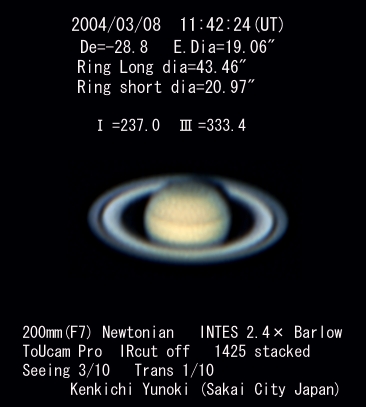|
The Cassini-Huygens mission
|
South up
 Original image tiff 500kB 1000X800
Original image tiff 500kB 1000X800
As Cassini closes in on Saturn, its view is growing sharper with time and now reveals new atmospheric features in the planet's southern hemisphere.
Atmospheric features, such as two small, faint dark spots, visible in the planet's southern hemisphere, will become clearer in the coming months. The spots are located at 38 degrees south latitude.
The spacecraft's narrow angle camera took several exposures on March 8, 2004, which have been combined to create this natural color image. The image contrast and colors have been slightly enhanced to aid visibility.
Moons visible in the lower half of this image are: Mimas (398 kilometers, or 247 miles across) at left, just below the rings; Dione (1,118 kilometers, or 695 miles across) at left, below Mimas; and Enceladus (499 kilometers, 310 miles across) at right. The moons had their brightness enhanced to aid visibility.
The spacecraft was then 56.4 million kilometers (35 million miles) from Saturn, or slightly more than one-third of the distance from Earth to the Sun. The image scale is approximately 338 kilometers (210 miles) per pixel. The planet is 23 percent larger in this image than it appeared in the preceding color image, taken four weeks earlier.
The Cassini-Huygens mission is a cooperative project of NASA, the European Space Agency and the Italian Space Agency. The Jet Propulsion Laboratory, a division of the California Institute of Technology in Pasadena, manages the Cassini mission for NASA's Office of Space Science, Washington, D.C. The imaging team is based at the Space Science Institute, Boulder, Colo.
[NASA/JPL/Space Science Institute]
|
|
Christophe Pellier (C14 ; ATK-1HS)
|

Hi everyone, with much delay here are my (maybe) last Saturn images of the
season. They are all of average quality at best and conditions were fair.
Just two remarks :
1) Note the IR1000 image of march 8th. The 1-micron filter was used with the
same method as for the UV filter : the ATK-1HS used in long-exposure mode
along with the C14 and a short focal lenght. Each frame was exposed 2
seconds and one thousand has been stacked (it has been long to grab them all
;o) ). Saturn's globe is quite dark at this wavelenght, and I was just
wondering if the image was a bit affected by methane absorption, as for my
Jupiter image of march 6th. Cassini took an image at 720 nm on february 16th
and the belts/zones pattern looks similar to me
(http://photojournal.jpl.nasa.gov/catalog/PIA05381).
2) Some changes in the globe have been taken place in near-IR, in march.
With the IR700 filter two belts have appeared, the first one around -45° and
the second near the SPR. From december to february those two belts were not
present in the images. With the IR780 filter, the SEB looked suddenly thick
in march, while it was totally not present in the previous monthes.
Best wishes
[Christophe Pellier Bruz City , France]
 ALPO-Japan Latest ALPO-Japan Latest

 Saturn Section Saturn Section
|


 Original image tiff 500kB 1000X800
Original image tiff 500kB 1000X800 
 ALPO-Japan Latest
ALPO-Japan Latest

 Saturn Section
Saturn Section